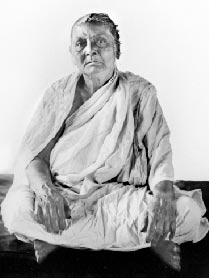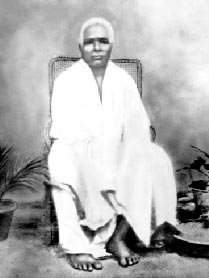Gauri-Ma

Gauri-Ma's original name, given by her family, was Mridani. She was also called Rudrani. She was born in 1857. Her father, Parvati Charan Chattopadhyay, and mother, Giribala Devi, were both very devoted to God. Giribala composed many devotional songs and hymns.
Even as a child, Gauri-Ma was fearless and uncompromising, and no external pressure could make her deviate from a resolution which she considered right. Her relatives arranged her marriage against her will when she was thirteen, but her mother allowed her to run away and hide herself. She later on accompanied a group of monks and nuns to Hardwar and spent several years wandering alone, sometimes disguised as a man. During her itinerant days, Gauri-Ma practised severe austerities, such as fasting, observing silence, meditating and studying scriptures. Finally she returned to Kolkata.
Drawn by a mysterious pull, Gauri-Ma came to Sri Ramakrishna in the company of Balaram Bose. Sri Ramakrishna wanted to fulfill a special mission through Gauri-Ma. He realized that the women of the society were terribly neglected, especially in the area of education, and it was his wish that Gauri-Ma should work among them. Gauri-Ma looked upon Sri Ramakrishna and the Holy Mother as her own parents. She had a strong desire to practise austerities in a secluded place, and left for Vrindaban. There she met the Holy Mother when the latter was visiting Vrindaban after the Master's passing away.
Later, when she took sannyas, Gauri Ma came to be known as "Gauri Puri Devi". In 1894, Gauri-Ma founded the Sri Saradeshwari Ashrama for women on the banks of the Ganga at B arrackpore in Kolkata. The Holy Mother praised the way she took care of the girls there. During the Master's birth centenary in 1936, Gauri-Ma gave an address in Bengali, which was broadcast on All India Radio. On 28 February 28 1938, the day of Shivaratri, Gauri-Ma started consciously preparing for death and passed away the following day.
Yogin-Ma

Yogindra Mohini Mitra, or “Yogin-Ma”, as she was known to the devotees of Sri Ramakrishna, was born on 16 January 1851 at Baghbazar in North Kolkata. Her father, Prasanna Kumar Mitra, was a well-known physician. When she was seven, she was married to Ambika Charan Biswas. The latter turned out to be a libertine, and Yogin-Ma returned with her daughter to her parents' place.
In 1882, Yogin-Ma met Sri Ramakrishna for the first time at Balaram Bose's house. She would bring him various dishes prepared by herself, which Sri Ramakrishna would eat with much relish.
Yogin-Ma had been initiated into a Devi Mantra. The master confirmed this and asked her to keep repeating it. Yogin-Ma soon met the Holy Mother Sarada Devi, and the two were immediately drawn towards each other.
In the middle of 1885, Yogin-Ma and a few other women devotees went to the Car Festival at Panihati and watched the Master as he danced among the huge crowd. Yogin-Ma used to say that the women used to feel that the Master was one of them and that they never felt any shyness in his presence. She took the Master's permission and went to Vrindaban to spend her days in austerity. She came to know of the Master's death from the Holy Mother while in Vrindaban. She became a close companion of Holy Mother. Whenever Holy Mother visited Kolkata, Yogin Ma would go to Mother’s house every day and do household work there.
Yogin-Ma used to look upon the disciples of Sri Ramakrishna as her own children. On 20 November 1900, she underwent Purna–Abhisheka, a special Tantric Rite. Later, she was initiated into Vedic sannyasa by Swami Saradananda in Puri. The latter consulted her before beginning his monumental work, Sri Sri Ramakrishna Lila-prasanga in 1909.
On 4 June 1924 at 10:25 p.m. Yogin-Ma passed away at Udbodhan, next to the room where the Holy Mother had lived. The Holy Mother used to describe her as one of her two eternal companions (the other being, Golap-Ma).
Golap-Ma

Golap Sundari Devi, known to devotees as Golap-Ma, was born in a brahmin family of North Kolkata, probably in the late 1840's. She was married off young, but her husband died after a few years, leaving her with two small children, a son and a daughter. Her daughter died prematurely, leaving a void in her life.
Seeing Golap-Ma's terrible suffering, Yogin-Ma, who was her neighbour, came to her help and took her to Sri Ramakrishna one day in 1885. The Master touched her head, and all grief left her. The Master introduced Golap-Ma to the Holy Mother and told her “Keep your eyes on this brahmin woman. She will live with you permanently.” Golap-Ma was one of Sri Ramakrishna's main women disciples and she often got the opportunity to render personal service to him. Not only did she carry his food to him, but also cleaned his room. The Master visited her dilapidated house on 28 July 1885.
One important trait of Golap-Ma's character was that she was not egoistic. Because of her outspoken nature, she was often misunderstood and criticised by other devotees, but she never left the Master or the Holy Mother. After the Master's passing away, Golap-Ma accompanied Holy Mother to Vrindaban. Later, she became Holy Mother’s constant companion. In Kolkata, she lived with Mother and took charge of running the household.
Holy Mother passed away in 1920 and Golap-Ma lived for four years after that. She died at Udbodhan on 19 December 1924.
Gopaler Ma

Aghormani Devi (popularly known as Gopaler Ma) was born in a brahmin family in the year 1822 at Kamarhati, a northern suburb of Kolkata. She was a child widow. She was initiated into spiritual life by her husband's family, with the child Krishna as her Chosen Ideal, and was given the Gopala Mantra. Her love and energy were thus directed towards her beloved Gopala. She sold her jewellery and husband's property, invested the money she got from it and lived on the interest accruing from it. She shaved her head as was customary amongst widows, and led an intensely contemplative life in a temple garden at Kamarhati. She would rise at two in the morning and continue her spiritual practices till eight. She would then clean the temple and the worship vessels, pick flowers, and make garlands and sandal paste. She would meditate under a Bilva tree after a bath in the Ganga, cook food and offer it to the boy Gopala, partake of the Prasad and then rest a while. She would practise japa again until evening, listen to the vespers, have a simple light supper and then practise japa again until midnight. She followed this routine from 1852 to 1883.
In 1884, she came in contact with Sri Ramakrishna. But whenever she came to Sri Ramakrishna, the latter would say nothing of spiritual matters, but would ask her to bring whatever she had cooked at home for him. This, at times, evoked mixed feelings, but the Master's pull was too great. In the spring of 1885, she gained a vision of Sri Ramakrishna which melted into the boy Gopala. She started having an uninterrupted vision of her Chosen Deity. Sri Ramakrishna told her that she had attained the goal of her spiritual practices.
After the passing away of Sri Ramakrishna, Gopaler Ma was grief-stricken, but repeated visions of the Master consoled her. She would occasionally visit the Baranagore Monastery. In 1903, she fell seriously ill, but her exalted mood did not want a whit. During her last days, she was looked after by Sister Nivedita. The end came on 9 July 1906. She was carried to the Ganga, where she breathed her last at dawn, touching the holy waters of the river.